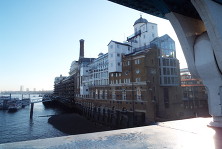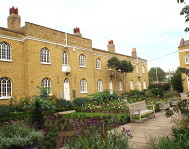








The Lime Kiln in Burgess Park was built by builders' suppliers Burtt and Sons in 1816. Quicklime was an essential component in the production of mortar and was needed in large quantities in the nineteenth century for the building boom fuelled by the massive growth in the population of London. Coal and limestone were transported to the kiln along the Grand Surrey Canal and were then burned in the kiln for three days. As well as being essential for the building trade, quicklime was often an ingredient in fertiliser and 'limelight', made by the burning of quicklime, used to illuminate Victorian theatres.
http://www.bridgetonowhere.friendsofburgesspark.org.uk
Lime Kiln, Burgess Park
By the end of the 19th century, small local kilns like this one had become unprofitable as the building of the railways made larger industrial works more viable. Burtt and Sons' kiln was used until the 1950s but the company dealt in other aggregates such as Portland cement and did not leave the Camberwell site until the 1960s when the surrounding area was being developed into Burgess Park. The kiln is Grade II listed and restored in 2002. An accompanying plaque says that it remains "as a memorial to the building workers of a century and a half of London's growth."
Watercolour by Guy Miller, 1927
Web discoveries
- UK Casino Not On Gamstop
- UK Casino Not On Gamstop
- Non Gamstop Casino
- Casinos Not On Gamstop
- Non Gamstop Casinos
- Non Gamstop Casinos
- Non Gamstop Casino
- Casino Sites Not On Gamstop
- Slots Not On Gamstop
- Casinos Not On Gamstop
- UK Betting Sites Not On Gamstop
- UK Casino Not On Gamstop
- Best Non Gamstop Casinos
- Betting Sites
- Non Gamstop Casino Sites UK
- Best Non Gamstop Casinos
- Non Gamstop Casino
- Casinos Not On Gamstop
- Non Gamstop Casino Sites UK